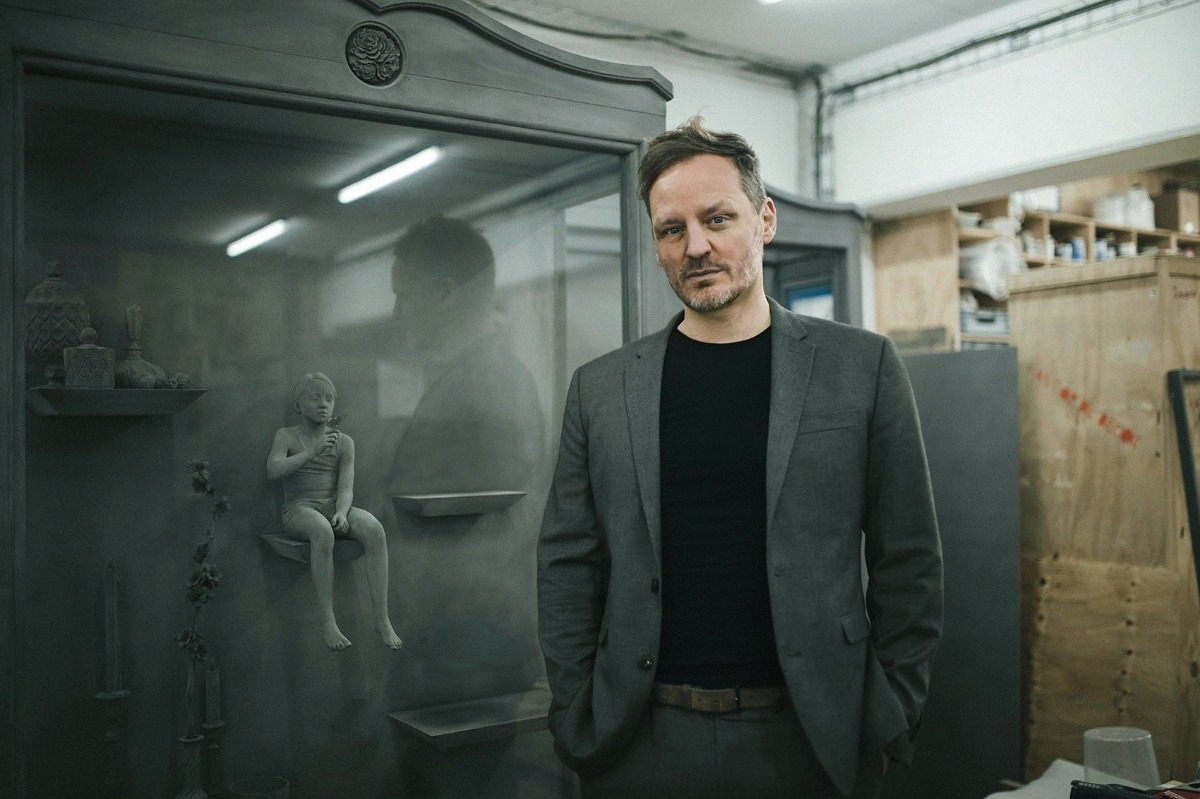
Journey to the Vanishing Point
An interview with Belgian multidisciplinary artist Hans Op de Beeck about his solo show at The Nordic Watercolour Museum
During the light nights of the Nordic summer, internationally celebrated Belgian multidisciplinary artist Hans Op de Beeck has brought his evocative nocturnal scenes to the picturesque town of Skärhamn, Sweden, at The Nordic Watercolour Museum. From May 26 to September 22, his solo exhibition “Vanishing Point” will feature over twenty large black-and-white watercolour paintings alongside his latest animated film of the same title. Adding an enchanting twist to the experience, the museum will also showcase a collection of Op de Beeck’s most recent sculptures, including the acclaimed “Danse Macabre” (2021)—a baroque, life-size monochrome sculpture of a merry-go-round that absurdly and festively reflects on mortality. This sculpture is one of many works by the artist that will be displayed during the summer exhibition at The Nordic Watercolour Museum.
Hans Op de Beeck. Vanishing Point (video still) (2023) © Studio Hans Op de Beeck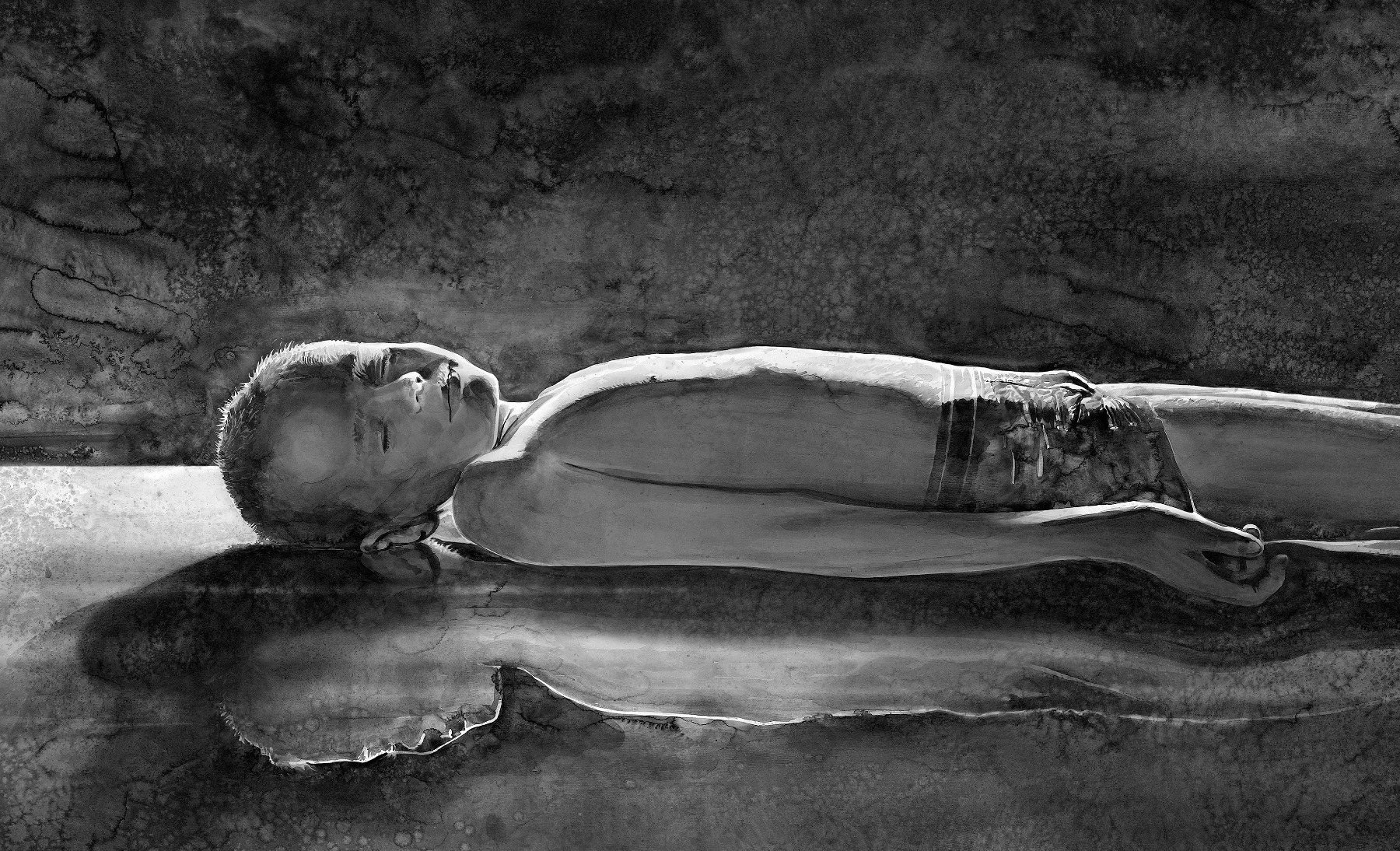
Classical metaphors seamlessly morph into contemporary forms in Hans Op de Beeck’s hands, resonating deeply with life as we know it. In this exhibition, he employs the concept of the “vanishing point” as a metaphorical gateway, guiding us from the tangible and familiar into the realm of the unknown and ethereal. The artist reflects on his show, stating, “My exhibition brings together watercolours, sculptures, and a film around this theme in a playful and freely associative manner. The works do not illustrate a specific theory or viewpoint; instead, they evoke an unfamiliar mood, the journey of intriguing fictional characters, untold tales in deserted landscapes, and meaningful yet subtle gestures... serving as seeds for potential stories in the viewer’s imagination.”
Hans Op de Beeck. The Boatman (2020) © Studio Hans Op de Beeck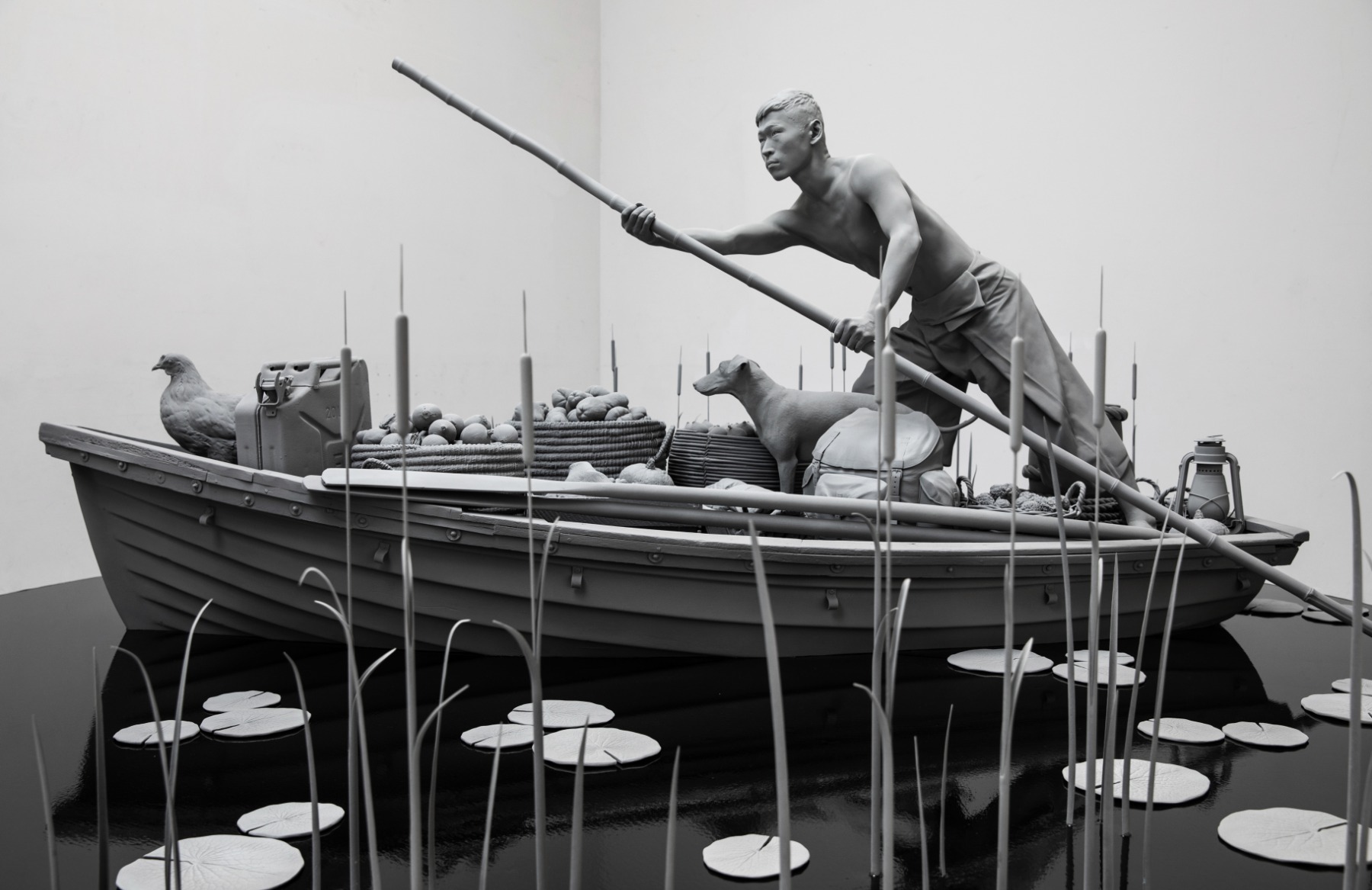
Characteristic of the artist, both his sculptures and watercolours on view are executed with meticulous attention to detail, inviting the spectator’s gaze for introspective wanderings. The large, elaborate watercolours, with their immersive storytelling and cinematic quality, depict enigmatic fictional places, blending grand panoramic views, natural landscapes, suggestive interiors, and close-ups of bodies and props. These works offer the spectator a collection of subtle references and layers that convey much more—warmth, tenderness, and everyday wonders alongside deeper, melancholic reflections, recognizing the sacredness of our time here.
In a pre-show interview with Arterritory, the artist offers further insights about the exhibition and the watercolors created during dusk-till-dawn sessions in his studio.
Hans Op de Beeck. The White Peacock (NWM) (2024) © Studio Hans Op de Beeck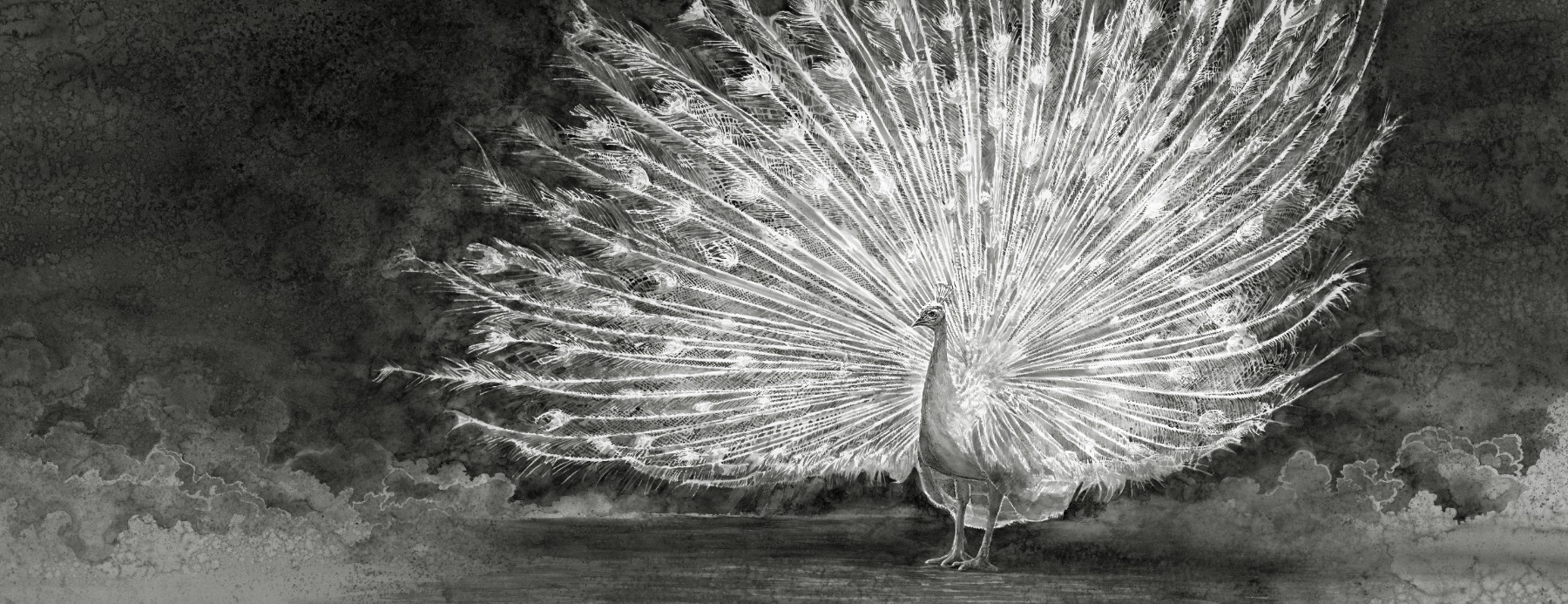
Your solo show at The Nordic Watercolour Museum features a mix of large black-and-white watercolour paintings, a brand-new animated film, and monumental sculptures. There seems to be a touch of playfulness in the curatorial concept of this exhibition. How did it come together?
Indeed, since I am, quite outspokenly, a multi-disciplinary artist, the director of the museum preferred to stretch the museum’s own concept a bit this time. From the start, I felt they wanted to show a slightly broader idea of what I stand for as an artist than solely my works on paper.
It is an exhibition that opens with an extensive drawing cabinet of 22 large watercolours, but then leads you to a projection room with my new film of animated watercolours, and from there you then end up in two consecutive museum halls with large sculptural pieces, including a monumental sculpture of a life-sized, alienating merry-go-round.
Even though sculptures, film and works on paper indeed are entirely different media, thematically all the works fit together quite seamlessly, as they all are silent reflections on the human condition.
Hans Op de Beeck. Lisah (variation, NWM) (2024) © Studio Hans Op de Beeck
Silent fictional characters — men, women and children — often depicted with their eyes closed in a moment of tranquillity or heightened concentration, appear in the watercolours, the film and the sculptures. And dark, mysterious, uncanny interiors and natural landscapes equally take shape in those three media as well. The exhibition builds bridges between those diverse media in a fairly organic way.
The specific content and needs of a work determine the form, dimensions or duration in which the work ultimately takes shape, but the very medium itself is never a goal.
Even though I, of course, would have been totally fine to solely show watercolours, I am happy that now I can share the larger breadth of my work.
Hans Op de Beeck. Sleeping Girl (2017) © Studio Hans Op de Beeck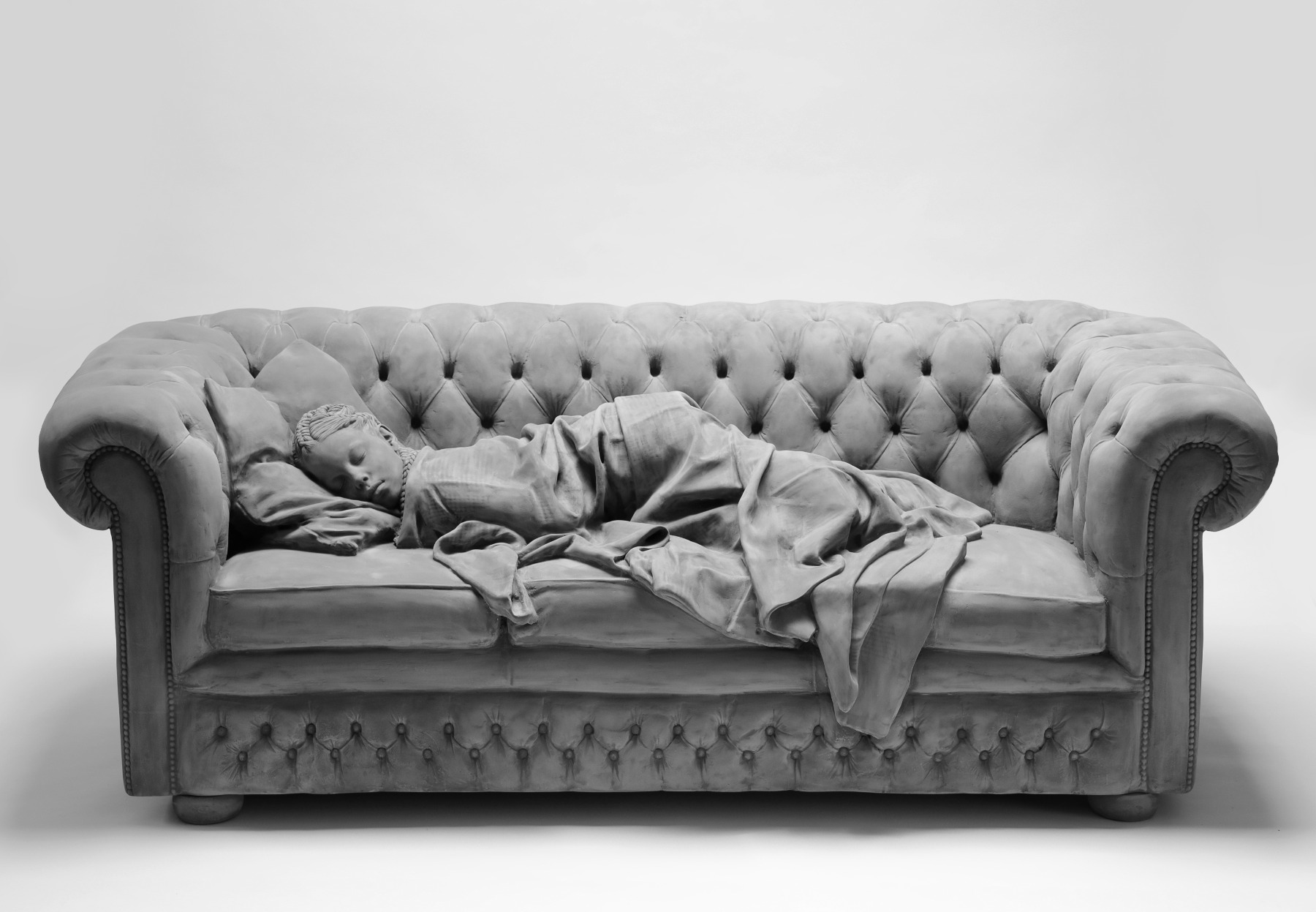
The concept of a “vanishing point” usually brings a sense of order and perspective. Yet you use it to suggest a transition into the unknown. How is this concept reflected in the artworks you are presenting at The Nordic Watercolour Museum?
The title of both my exhibition as well as the new animated film, ‘Vanishing Point’, indeed firstly refers to a point in the picture plane of a perspective view where mutually parallel lines seem to converge in a three-dimensional space. At the level of a “vanishing point” in the distance, we can no longer perceive three-dimensional depth, as if all visual information over there dissolves: from there onward, we lose grip on what is conceivable.
I love to use the term metaphorically, as a tipping point from which we shift from measurability and legibility into the unknown, indecipherable and incomprehensible, or from the concrete to the abstract, mental or spiritual.
“Vanishing”, according to the dictionary, means “disappearing suddenly and completely”, or, in mathematical terms, “becoming zero”. I am intrigued by the moment when we, as human beings, briefly become nothing or nobody, when we let go of our linguistic, logical and rational understanding of the world and slip into a moment of self-loss and timelessness.
These are moments when we forget our identity and are momentarily nobody and nowhere, while our alert sense of time and any sense of urgency seem to disappear. This mental no man’s land, this emptiness and silence, can serve as a small oasis for our often overly busy, preoccupied minds.
In a broader, philosophical sense, ‘vanishing’ is also about abandoning our ego, accepting our relativity, our insignificance as humans and individuals in relation to the unfathomable idea of eternity and the dizzying infinity of the universe.
As we age, we are increasingly faced with the sobering “vanishing” of family and friends around us: in the blink of an eye, a grandparent, parent, sister, brother, or friend disappears from your life. To suffer this kind of loss is confrontational, brutal and absurd. Much of my work touches on the theme of the memento mori, a reminder of the temporality of our lives. It bestows, in a positive sense, brilliance and value upon the small and essential moments in our lives.
The sublime quality of nature, the enigmatic darkness of the night, being on the road without a conscious destination, slipping into sleep and dreams, or being absorbed into the illusion of a game or the parallel world of a novel — all of these can transport one into the experience of an unexpected and sudden fading of one’s sense of identity, into a moment of self-loss.
My exhibition brings together watercolours, sculptures and a film around this theme in a playful and freely associative manner. The works are not illustrative of a particular theory or point of view, but rather introduce the onset of an unfamiliar mood, the journey of an intriguing fictitious character, an untold tale in a deserted landscape, a minor yet meaningful gesture… as the seeds for possible stories in the viewer’s thoughts.
Hans Op de Beeck. The Journey (variation, NWM) (2024) © Studio Hans Op de Beeck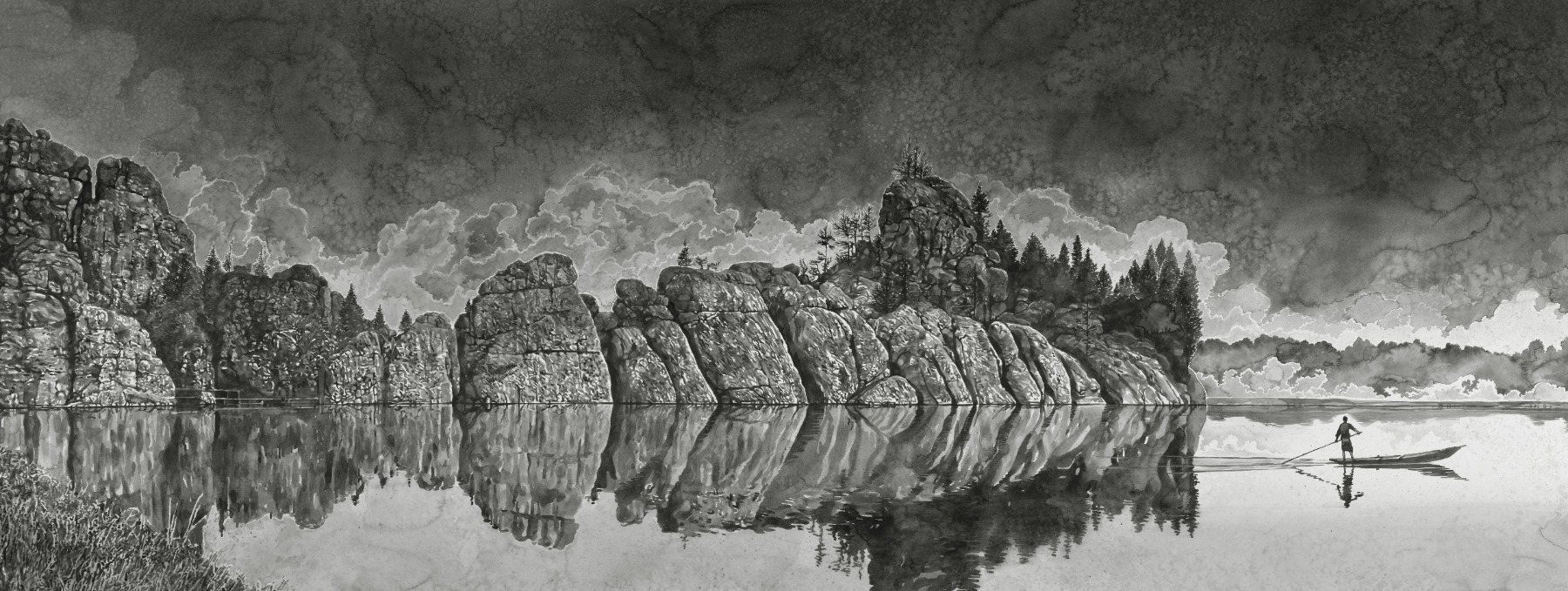
Over the years, you have had numerous nightly painting sessions. How do you emotionally connect with and navigate the fluid, sometimes unpredictable nature of this medium?
The watercolours in the show — evocations of depopulated winter and night landscapes, wild as well as serene seascapes, lakes, amusement parks, mysterious houses, enigmatic figures, wondrous animals and props — were indeed, again, mainly painted at night.
Nighttime to me, as to many creative souls, is a very particular mental zone where time and space seem to merge. At night I can paint without any form of interruption, as if in a daze, crawling around my large sheets of paper on the floor, while an image emerges most gradually, layer by layer.
My deep connection with this somewhat merciless medium arises from its beautiful simplicity: it is just you and your brush, a bowl of water, black pigment and your paper. No excuses, no escape or corrections possible. That high concentration and the choreography of your hand with its careful, caressing movements resembles a refined ritual or a most focused meditation.
It is a delicate process where the white paper is your light source. If you work on a watercolour for too long and paint away too much of the white of the paper, you literally extinguish the light and all the life in the image. If you work in acrylic or oil paint, covering mediums, you can always add light. With the brush you can then add covering light tones to bring back the light. With the totally transparent watercolour medium, that isn’t possible, and you work the other way around: what you save and leave untreated is your light. So, if I paint a fountain that is lit at night, the light in the water is the naked white of the paper. You never add light in watercolours, the light is your paper. It is a reverse way of thinking and making.
The unpredictable nature of the medium, which you mentioned, is choreographable to a certain degree. Over the years I learned to guide the blending and bleeding of the water and the pigment.
Hans Op de Beeck. Nocturnal Seaview (NWM) (2024) © Studio Hans Op de Beeck
Your “Danse Macabre” merry-go-round reflects on mortality through a lens of festivity and absurdity. Do wit and lightheartedness play a role in navigating and conveying profound themes in your art?
They surely do. Lightheartedness and wit are some of the available tools to give more balance to dark, profound and essential reflections on the tragicomic human condition. I love both playfulness as well as serene calm to communicate with my audience. I am averse to the grand hollow gesture of melodrama, pathos, loud, soulless spectacle and visual and substantive display. Even though my installations sometimes have monumental, landscape-like dimensions, the mood and experience always revolve around essence, subtlety, silence and simplicity.
My “Danse Macabre”, the life-size, monochrome grey sculpture of a strange carousel, appears as if petrified and inert, stalled, covered in colourless dust or a layer of ashes, if you like. The “classic” carousel as we still know it today in many variations, is usually a baroque, brightly coloured, sparkling kitsch object that refers nostalgically to the times of yesteryear, when the attraction had little competition from all the fairground commotion we see today.
The carousel has become a sporadically recurring subject in my work. I consider it a typically human, somewhat tragicomic staging of entertainment. It is also a rather absurd object: we lift our children and place them on wooden horses to subsequently let them spin aimlessly in circles. Such fairground objects or constructions, when not or no longer in use, take on a melancholic quality.
A dream about or a memory of your childhood can be sweet like a radiantly polished merry-go-round, but can also be the undressed afterimage of an unprocessed past. The title “Danse Macabre” alludes to the halted procession of carriages, horses and objects that refer to death, which I designed as a kind of over-sized still life. The still life as a historical genre has the tradition of being a “memento mori”, a reminder of the ephemerality and relativity of our lives.
Hans Op de Beeck. Danse Macabre (2021) Photo: Stella Ojala © Studio Hans Op de Beeck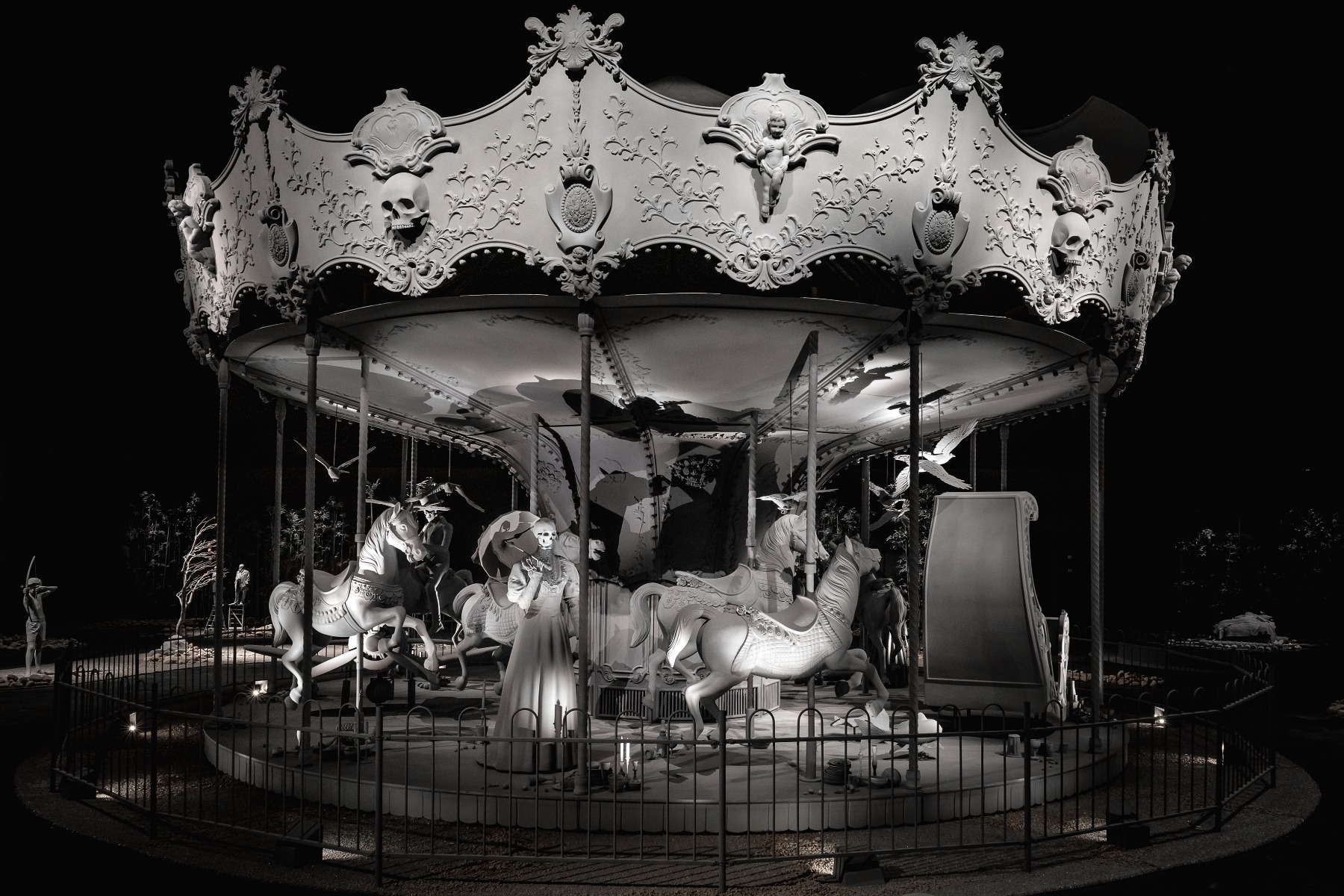
The grey monochrome of “Danse Macabre” gives the carousel a completely petrified, inert appearance, as if it were a fossil, frozen in time. By removing all the colour, I stripped the carousel of the last layer of vibrancy and moved it further away from the actual object. This work is a sculptural interpretation, not an imitation. The matte, grey colour subdues the image, like an ash-covered remnant object after a major fire.
Silenced or bygone cheerfulness gives objects that are primarily made to be in motion and crowded with people a sombreness, like the emptiness after a party.
To insert a humorous and playful note in this grey world, I added cheerful skeletons of a finely dressed horseman, a lady in a long dress with a parasol, a dandy-like smoking clown figure, and a child with a seal on a leash; nods to James Ensor and a fin-de-siècle feel, or, for example to the festive Día de Muertos in Mexico.
Hans Op de Beeck. Burning House (2024) © Studio Hans Op de Beeck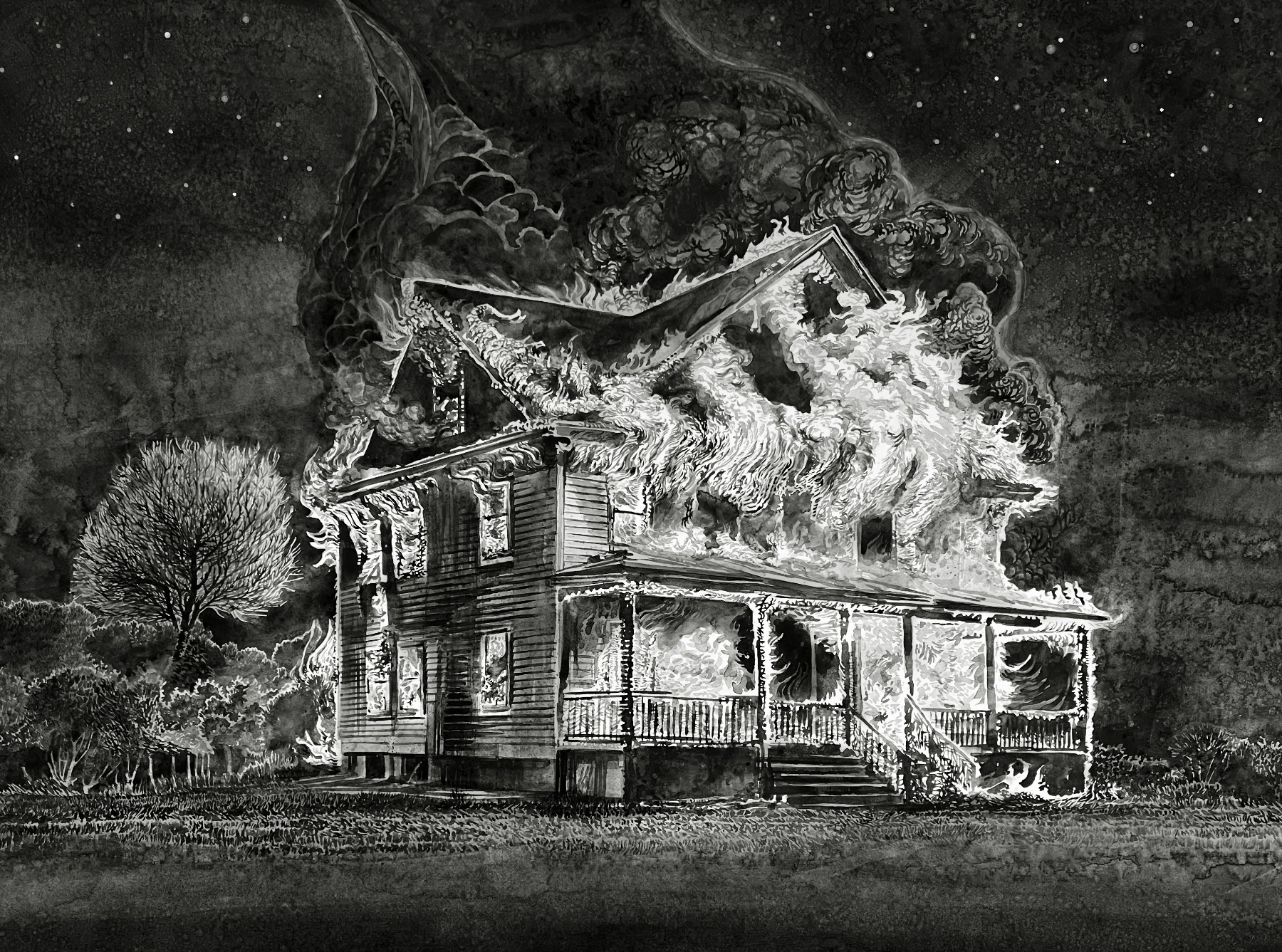
How do you personally interpret the Swedish concept of “mysig” or the Danish “hygge”—those small, sacred joys and the warm, pleasant atmosphere of togetherness? Do these concepts influence your art in any way?
They do, as they too are part of the human experience. Too easily artists might consider them as not valuable or profound. Of course, this doesn’t mean that we should strive to naively create works on contentment, coziness and comfortable conviviality, either.
But I have always resisted the compulsive ideas that art today, for example, should only be directly about current socio-political events in an activist manner, or that art should always be unruly, unaesthetic, somewhat disturbed, raw and edgy. Those are possible and potentially valuable options, and I do celebrate and defend the existence of any possible definition of art. But, in addition to the deeper, melancholic, contemplative reflection that I try to offer about our tragicomic existence, suffering, and search for catharsis and solace, I believe that art should also make room for beauty or warm, welcoming feelings such as tenderness. In the 1990s, it seemed that art had to be mercilessly hard, sobering and sterile, and many people still adhere to that school today. In that movement, there is a bit of a belittling irony and laughing about beauty, endearment and softness, while these are just as essential feelings as fear, loss, anger or derailment. Positive emotion is often confused with sentimentality, or put aside as naive, but that is, of course, nonsense. Sometimes we are too easily ironic about everything. I also think that kitschy, superficial sentimentality has little to offer in art, but this should not be confused with the authentic positive feelings of warmth and softness, which can tell something truly essential as well. It is only more challenging and trickier to figure out how to deliver that well and effectively, with a sense of depth and sincerity.
Hans Op de Beeck. The Pier at Night (NWM) (2024) © Studio Hans Op de Beeck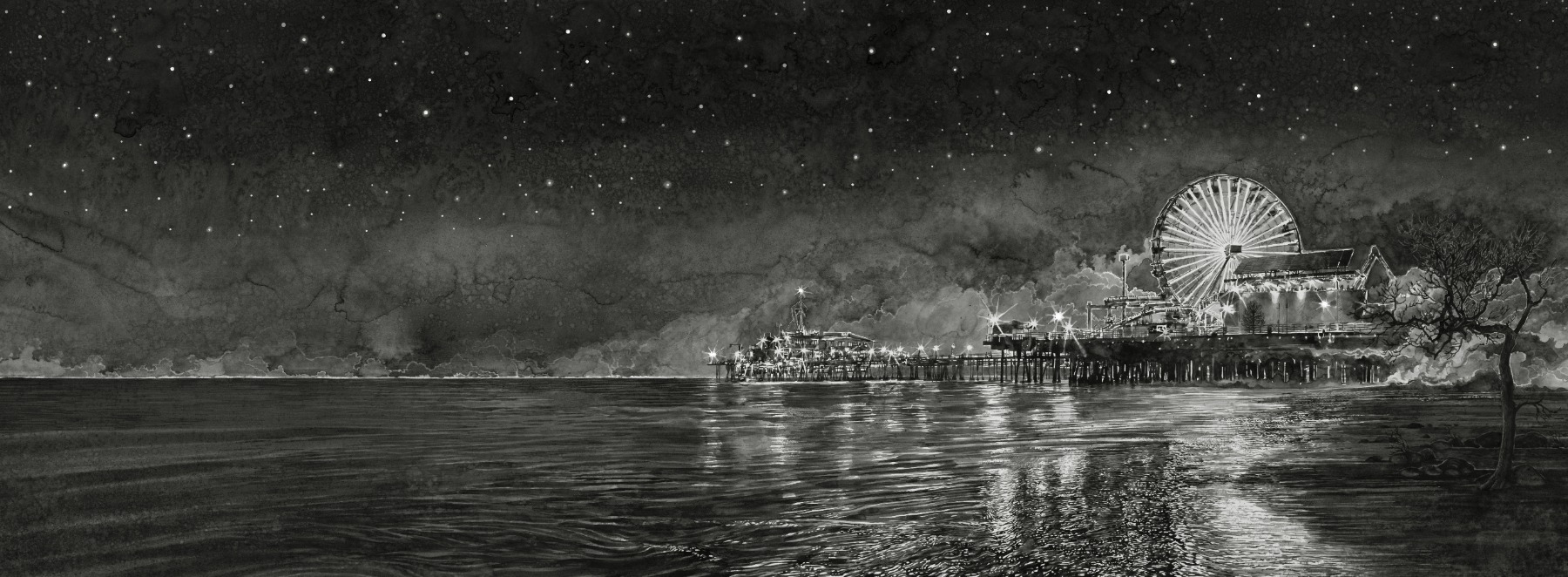
***
Hans Op de Beeck ‘Vanishing Point’
Nordic Watercolour Museum, Skärhamn
26 May – 22 September, 2024